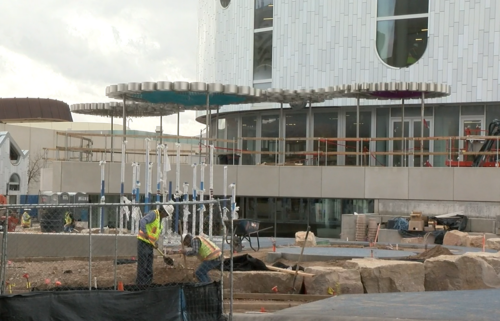Your favorite beaches around the world could disappear because of the climate crisis, development

It’s easy to see why millions of people flock to the beach every year.
They are dynamic places — and not just because they’re great for relaxing, surfing or people watching. With each crashing wave and changing tide, billions of pieces of sand and rock are constantly rearranged.
This is what nature intended.
What it did not, some scientists say, are the buildings that tower over some of the world’s most popular beaches.
In many cases, this real estate that is coveted for its proximity to the beach is disrupting natural processes and in many places, increasing the rate of erosion.
Compounding the problem are the jetties, groins and other man-made structures built to keep sand from moving.
“Once you block the movement of sand, it may move to deeper areas offshore instead of replenishing the beach,” said Kristina Hill, an associate professor at the University of California, Berkeley.
Combine this with rising seas and more intense storms caused by the climate crisis, and you have an existential threat to some of the best beaches around the world.
“As sea levels rise, that beach wants to be somewhere inland. And in order to try to get there, we expect that it will take away the beach much faster than it is right now,” said Orrin Pilkey, director emeritus for the Program for the Study of Developed Shorelines.”Sea level rise will spare nobody.”
Here’s how some of the world’s most famous beaches are imperiled by sea level rise.
Waikiki Beach, Honolulu, Hawaii
Framed by highrise buildings and the Diamond Head crater, when you think of Hawaii, you think of Waikiki Beach.
Sadly, the beach is at risk of sinking beneath the very waves that bring surfers to it within the next 15 to 20 years, according to a 2017 Hawaii Climate Commission report.
Losing Waikiki would not only be devastating for its value as a landmark, it would also be a blow to Hawaii’s tourist economy: Visitors to the beach bring in $2 billion annually.
Hawaii, for its part, is taking climate action. The state is aiming to generate 100% of its energy from renewables by 2045.
But scientists say we are already locked into some amount of sea level rise from the greenhouse gases humans have added to the atmosphere, and without swift global action to reduce emissions, Waikiki’s fate remains uncertain.
South Beach, Miami Beach, Florida
Dubbed the “canary in the mine shaft” by its own mayor when it comes to the impacts of sea level rise, South Beach and all of Miami Beach’s high-end real estate sits just feet above sea level.
The city is taking action to keep the most vulnerable areas dry by building sea walls, installing pumps and raising roads, but recent hurricanes combined with rising seas have eroded parts of South Beach.
After past storms, the city has tried to replenish the sand lost from its famous beaches by dredging it up from offshore. But finding usable sand is becoming harder in an era of rising seas.
Since Miami Beach’s offshore reserves have been depleted, city officials are now exploring buying sand from the Bahamas and elsewhere to keep their beaches alive.
Copacabana Beach, Rio de Janeiro
One of Brazil’s most iconic beaches, Copacabana welcomes more than two million revelers to its annual New Year’s Eve extravaganza, plus millions more throughout the year to its sandy shores.
But Copacabana and several of Rio’s other popular beaches are highly vulnerable to the impacts of sea level rise. The threat has become more apparent in recent years, as a series of extreme storm surges have eroded stretches of the city’s beaches and sent sand onto surrounding streets.
Surfers Paradise, Gold Coast, Queensland, Australia
More than 90% of Australia’s population lives within 100 kilometers of the coast, so beaches are integral to the Australian way of life — and the country’s economy.
But many of the country’s beaches are imperiled by the combined impacts of sea level rise and intensive coastal development.
Surfers Paradise — located on the Gold Coast and arguably the country’s most famous beach — is also among the most vulnerable because of the high rises that hug its sandy shores.
Like many other urban beaches, Surfers Paradise is fighting erosion with beach nourishment, but as seas rise, replacing lost sand will grow more costly: A 2012 analysis found that over the next century, beach nourishment could cost as much as $54 million per year.
In the short-to-medium term, the beach and city may be able to stay dry. But the same report found that if sea levels rise two meters over the next century, as some extreme climate scenarios predict, it could be more than the city can withstand, even with careful planning.
Ocean City, Maryland
One of the busiest and most crowded beaches in the US, Ocean City and its lively boardwalk are huge economic drivers for the state of Maryland.
Maintaining those assets is expensive work. Ocean City’s beaches have typically been replenished every four years, but after a winter storm caused serious erosion in 2016, the city was forced to begin dredging and pumping sand on the beach ahead of schedule, at a cost of $12.7 million.
And based on the latest scientific projections, beach upkeep will be even more difficult in the future.
A new report from the UN’s Intergovernmental Panel on Climate Change found tropical cyclones are expected to grow more intense as oceans continue to warm. This, combined with projected increases in global sea level, could amplify storm damage in places like Ocean City.
Santa Monica Beach, Los Angeles
Drawing millions of visitors to sunbathe, surf and people watch, LA’s Santa Monica Beach won’t be spared the impacts of the climate crisis.
Over the years, the beaches here have been drastically altered by humans. Millions of yards of sand have been brought in and breakwaters built to create the wide stretches of beach we see today. But erosion continues to be a problem.
To fight it, a pilot program run by the Bay Foundation is underway on a 3-acre stretch of the beach to cultivate native plants and dunes as a buffer against sea level rise.
These solutions will help make the beach more resilient. But with a 66% chance that sea levels will rise more than three feet in the next 80 years, the long-term future of Santa Monica remains cloudy.
Barceloneta Beach, Barcelona
Like all of Barcelona’s eight beaches, Barceloneta is a man-made creation. And with little space to retreat because of the surrounding urban area, the beach will face challenges as sea levels creep higher.
In 2008 and 2010, a series of strong storms eroded large sections of several of Barcelona’s beaches, including Barceloneta. The city repaired the beaches, but in the years since, about half of the sand has been reclaimed by the sea.
With sea levels now expected to rise more than previously predicted by 2100, it will likely be difficult for Barcelona to maintain its status as a premier destination for urban beachgoers.
Ocean Beach, San Francisco
With its powerful waves, wide beach and close proximity to downtown San Francisco, Ocean Beach draws Bay Area surfers and outdoor enthusiasts of all stripes. But like so many other urban beaches, it faces a host of challenges.
Chief among them is erosion, and recent El Niño events have claimed as much of 180 feet of Ocean Beach’s sand.
To build resiliency in the face of future sea level rise, San Francisco is using a combined strategy of nourishing the beach with dredged sand and “managed retreat” — moving roads farther inland away from the erosion to allow natural processes to take hold, while also fortifying critical infrastructure that could be in harm’s way.




